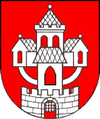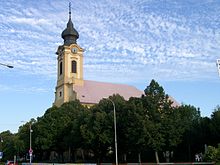Sereď
| Sereď | ||
|---|---|---|
| coat of arms | map | |

|
|
|
| Basic data | ||
| State : | Slovakia | |
| Kraj : | Trnavský kraj | |
| Okres : | Galanta | |
| Region : | Dolné Považie | |
| Area : | 30.454 km² | |
| Residents : | 15,444 (Dec. 31, 2019) | |
| Population density : | 507 inhabitants per km² | |
| Height : | 129 m nm | |
| Postal code : | 926 01 | |
| Telephone code : | 0 31 | |
| Geographic location : | 48 ° 17 ' N , 17 ° 44' E | |
| License plate : | GA | |
| Kód obce : | 504009 | |
| structure | ||
| Community type : | city | |
| Urban area structure: | 2 districts | |
| Administration (as of November 2018) | ||
| Mayor : | Martin Tomčányi | |
| Address: | Mestský úrad Sereď Námestie republiky 10 92601 Sereď |
|
| Website: | www.sered.sk | |
| Statistics information on statistics.sk | ||
Sereď (until 1954 Slovak "Sered"; Hungarian Szered , German Sereth ) is a small town in western Slovakia with 15,444 inhabitants (as of December 31, 2019).

geography
location
The city lies in the Danube lowlands on the right bank of the Waag ; the entire municipal area extends on both sides of the river. Due to the location in a lowland between the Dudwaag ( Dudváh ) and the Waag, there are only minimal differences in altitude in the municipality (124 to 130 meters above sea level).
population
According to ethnic groups live there:
- 96.16% Slovaks
- 1.32% Magyars
- 0.95% Czechs
- 0.65% Sinti and Roma
- 0.03% Russians
- 0.03% German
- 0.02% Ukrainians
The denominations are distributed:
- 72.52% Roman Catholic
- 20.77% non-denominational
- 1.97% Protestants (Evangelical Augsburg Confession)
- 0.15% Greek Catholic
- 0.14% Orthodox
history
Sereď was first mentioned in writing as Zereth in 1313 and was at that time on one of the most important trade routes between Buda and Prague (so-called “Bohemian Road”), on the border of two counties ( Pressburg and Neutra ). Due to its location, it developed into a large regional center with a cattle and grain market. However, this position was increasingly lost in the 18th century.
It was not until the connection to the Tyrnau horse-drawn railway from Pressburg to Szered in 1846 that the rather agriculturally oriented town began to flourish again. From 1871 the line passed to the Waagtalbahn and was nationalized in 1891.
Until the Waag was regulated in 1943, the town was also regularly hit by floods.
From 1941 to 1945 there was a concentration camp in Sereď in which Jews - mostly Slovak - were imprisoned for forced labor. At the same time, it also served as a collection point for transports to the Auschwitz-Birkenau extermination camp . The camp was under the Hlinka Guard until 1944 , after the suppression of the Slovak National Uprising and the subsequent military occupation of Slovakia by German troops, then in the meantime the SS Homeland Security Slovakia and then the SS under Alois Brunner . The labor camp in Sereď was a barracks before the war and was reopened as such after the war, where generations of soldiers received their basic training. Only in 2016 was the first Holocaust memorial in Slovakia opened in part of the barracks area. Building one is about Slovakia's participation in the Holocaust, building four is dedicated to the murdered Jews. Special exhibitions are held in building five. The restoration of the other barracks is awaiting funding.
After the Second World War, a nickel-processing industry was established through the planned economy; however, this ceased after the end of socialist rule.
City structure
In addition to the actual city, Sereď is also divided into the place Horný Čepeň (in Hungarian Felsö Csöpöny - incorporated in 1964) and the places that no longer appear as independent parts of the municipality:
- Dolný Čepeň (Hungarian Alsó Csöpöny , German Unter-Csepen ) - incorporated in 1944
- Stredný Čepeň (Hungarian Közép Csöpöny , German Mittel-Csepen ) - incorporated in 1944
- Seredské Nové Mesto (incorporated in 1882)
From 1971 to 1990 Dolná Streda was incorporated,
economy
Agrana runs a sugar factory here . Henkell & Co. Sektkellerei took over in 2000 the majority of shares in resident sparkling wine company Hubert JE sro Since 1953 the company produced here Sedita pastry and confectionery, the products include the popular filled wafers called Horalky (in Poland Góralki ).
In the past few years, several logistics centers have also opened up: Amazon , for example, opened a returns center in 2017 with an initial 1,000 employees. Not far from there is the LIDL logistics center with around 200 employees.
traffic
Sered is on the European route 58 (or European route 571 ), which leads from Vienna to Russia. At the station on the Galanta – Leopoldov railway line, the Sereď – Trnava line branches off . The road I / 62 crosses the Waag here, while the I / 35 connects the city with Galanta . The R1 expressway from Trnava to Banská Bystrica is connected to the local road network via junctions Sereď-sever (12), Sládkovičovo (14) and Galanta (16).
Twin cities
- Tišnov (Tischnowitz), Czech Republic
- Leopoldsdorf im Marchfelde , Austria
- Alblasserdam , Netherlands
Attractions
- Esterhazy Palace (1841) on the site of a former moated castle
- Roman Catholic Church of John the Baptist (1777)
- Marienkirche (1736)
- Holy Trinity Church (18th century)
- Lady Chapel (1832)
- Old Town Hall (1909)
- Catholic School (1879)
- Holocaust Museum
Sports
The football club ŠKF Sereď (formerly Hutník Sereď ) plays in the first Slovak league. Furthermore Basketball (Lokomotíva Sereď), Handball operated (Slavia Sereď) Floorball (FBC Insport Sereď Strikes), tennis (Tenisový klub Sered), boxing (boxing club Buldog Sereď) and table tennis (STK Mladosť Sereď).
sons and daughters of the town
- Miksa Weiß (1857–1927), chess master
- Martin Klein (1864–1924), Austro-Hungarian opera singer, violinist, entertainer, theater actor, theater director and theater director
- Heinrich Rieger (1868–1942), German-Czech dentist and art collector
- Rudolf Erdös (1876–1935), Jewish architect
- Filip Müller (1922–2013), Jewish author
- Jan Nagy (* 1945), weightlifter
Web links
Individual evidence
- ^ Barbara Hutzelmann, Mariana Hausleitner , Souzana Hazan: Slovakia, Romania and Bulgaria. Walter de Gruyter, 2018, ISBN 3-11049-520-1 , p. 44.
- ↑ Zuzana Vilikovská: First Slovak Holocaust museum opens. In: The Slovak Spectator , February 9, 2016, online . Retrieved March 7, 2017
- ^ Sered Holocaust Museum , Slovak National Museum. Retrieved March 7, 2017
- ↑ logistik-heute.de: Logistikimmobilien: Amazon return center in Slovakia , March 9, 2017 (accessed December 27, 2018)
- ↑ lidl.sk: Lidl vybudoval v Seredi najekologickejšie logistické centrum na Slovensku (accessed on December 27, 2018)





